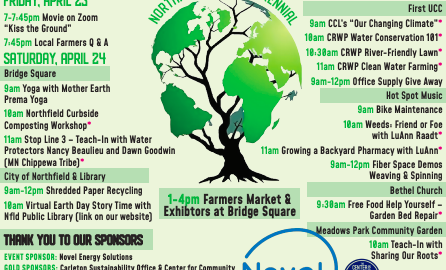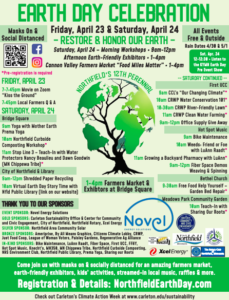This paper, written by Carleton student Reed Ebbinghaus for Kim Smith’s 2021 Environmental Law & Policy seminar, sets out a 20-year plan for managing invasive plants in Northfield, focusing on 1) effective institutional coordination and knowledge-sharing and 2) civic
involvement.
All posts by anAdmin
Proactive Invasive Plant Management in Northfield
This paper was written by Carleton student Zak Sather for Kim Smith’s 2021 Environmental Law & Policy seminar, recommends a 5-stage approach for invasive plant management in Northfield: 1) should communicate with surrounding entities including state and city governments, businesses, community organizations, and academic institutions to identify invasive plant threats; 2) prioritize these plants based on potential threats to economic, ecological, and human health; 3) shut down pathways by which invasive plants are introduced via humans; 4) identify the areas in town most susceptible to alien plant invasion; and 5) focus on revegetating and transforming these areas to protect them from invasive plants.

Northfield Earth Day Schedule of Events
The Future of Invasive Plants in Northfield
This paper was written by Carleton student Sarah Shapiro for Kim Smith’s 2021 Environmental Law & Policy seminar, lays out a 20-year plan for controlling invasive plants in Northfield. The proposal has three key points: acquiring staff and funding, developing an invasive plants database, and providing education to encourage public engagement.
The Honorable Harvest: Indigenous Knowledge for Sustainability
Robin Wall Kimmerer is a mother, scientist, decorated professor, and enrolled member of the Citizen Potawatomi Nation. She is the author of Braiding Sweetgrass: Indigenous Wisdom, Scientific Knowledge and the Teaching of Plants, which has earned Kimmerer wide acclaim. Her first book, Gathering Moss: A Natural and Cultural History of Mosses, was awarded the John Burroughs Medal for outstanding nature writing, and her other work has appeared in Orion, Whole Terrain, and numerous scientific journals. She tours widely and has been featured on NPR’s On Being with Krista Tippett and in 2015 addressed the general assembly of the United Nations on the topic of “Healing Our Relationship with Nature.” Kimmerer lives in Syracuse, New York, where she is a SUNY Distinguished Teaching Professor of Environmental Biology, and the founder and director of the Center for Native Peoples and the Environment.
Cultivating Carbon in your Home Garden
Resources created by Duncan Burnett, Luke Everson, Lisa Fisher, Kendal Otness for a St. Olaf environmental studies course, suggesting ways to enhance carbon sequestration in home gardens.
Carbon Sequestration for Church Communities
Slide show by Shannon Bayless, Helen Larson, Jordan Ketchem, & Katelyn LeBeque for St. Olaf environmental studies course on how church communities can enhance carbon sequestration through landscaping.
Native Planting Suggestions for Northfield
These recommendations were generated as a part of the Northfields Plants and Pollinators – Lawns to Legumes grant. These plants are some of the favorites of local pollinators, especially bumble bees like the Federally Threatened Rusty Patched Bumblebee, which is found in several areas around Northfield.
Looking Back to Look Ahead: Providing Temporal Context for the Spare or Share Debate Using Land Use
Carleton students Mariah Casmey and Nicola Lowry conducted a study that identified the changes in land use and bird populations in Rice County. As land use changes are deeply interconnected with social and political shifts, they conducted a historical analysis of the area to further understand the agents driving these changes. They tracked changes in land use by using manual classification of aerial photographs and satellite imagery from 1964 to present. Through this analysis, they observed increasing urban land, increasing forest cover, and decreasing land in agriculture in our study region. Historical research revealed societal trends such as the loss of small family dairy operations and the industrialization of agriculture as drivers of some of these changes. Comparing bird species with varying habitat preferences revealed correlations between their population sizes and land use change in this area. The most significant correlation was the decline of grassland species that occurred alongside increasing agricultural industrialization and the loss of small family dairies. Overall, the study reveals how human land management decisions shape the assemblages of species that can live in these altered landscapes.
Spare and Share as Applied to Land Management Practices of Farmers in the Rice County Area
Carleton students Jeremy Alsaker and Cooper Kohlman studied how farmers relate to “spare or share” theory in a rural midwestern agricultural context. They interviewed farmers to ask them about their management practices that fall under spare or share, as well as the reasons for adopting the practices. While spare or share focuses solely on the objectives of the land’s productive capacity and biodiversity, they found that farmers’ objectives were more complex. Conservation theories such as spare or share should better reflect landscapes where small-scale, individual management decisions are informed by factors such as economic considerations, long-term fertility, and the notion of family legacy. This requires adapting the core assumptions of the theory to reflect the priorities of the farmers and other land users who interact with it.
